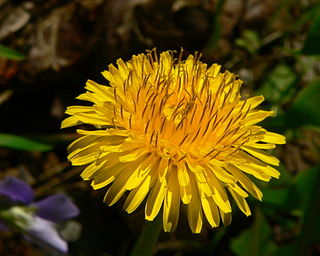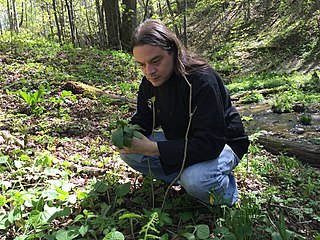
Rhubarb is the fleshy, edible stalks (petioles) of species and hybrids of Rheum in the family Polygonaceae, which are cooked and used for food. The plant is a herbaceous perennial that grows from short, thick rhizomes. Historically, different plants have been called "rhubarb" in English. The large, triangular leaves contain high levels of oxalic acid and anthrone glycosides, making them inedible. The small flowers are grouped in large compound leafy greenish-white to rose-red inflorescences.

Common chicory is a somewhat woody, perennial herbaceous plant of the family Asteraceae, usually with bright blue flowers, rarely white or pink. Native to Europe, it has been introduced to the Americas and Australia.

Freeganism is an ideology of limited participation in the conventional economy and minimal consumption of resources, particularly through recovering wasted goods like food. The word "freegan" is a portmanteau of "free" and "vegan". While vegans avoid buying, consuming, using, and wearing animal products as an act of protest against animal exploitation, freegans—at least in theory—avoid buying anything as an act of protest against the food system in general.

Lemonade is a sweetened lemon-flavored drink.

Foraging is searching for wild food resources. It affects an animal's fitness because it plays an important role in an animal's ability to survive and reproduce. Foraging theory is a branch of behavioral ecology that studies the foraging behavior of animals in response to the environment where the animal lives.

Allium tricoccum is a bulbous perennial flowering plant in the amaryllis family Amaryllidaceae. It is a North American species of wild onion or garlic found in eastern North America. Many of the common English names for this plant are also used for other Allium species, particularly the similar Allium ursinum, which is native to Eurasia. An edible plant, Allium tricoccum is used in a variety of North American and indigenous cuisines, and has also been used by Native Americans in traditional medicine. A French rendering (chicagou) of a Native American name for this plant is the namesake of the American city of Chicago.

Hypochaeris radicata – also known as catsear, flatweed, cat's-ear, hairy cat's ear, or false dandelion – is a perennial, low-lying edible herb often found in lawns. The plant is native to Europe, but has also been introduced to the Americas, Japan, Australia, and New Zealand, where it can be an invasive weed. It is listed as a noxious weed in the northwestern U.S. state of Washington.

Euell Theophilus Gibbons was an outdoorsman and early health food advocate, promoting eating wild foods during the 1960s.

Capsella bursa-pastoris, known as shepherd's purse because of its triangular flat fruits, which are purse-like, is a small annual and ruderal flowering plant in the mustard family (Brassicaceae).

Entomophagy in humans or human entomophagy describes the consumption of insects (entomophagy) by humans in a cultural and biological context. The scientific term used in anthropology, cultural studies, biology and medicine is anthropo-entomophagy. Anthropo-entomophagy does not include the eating of arthropods other than insects such as arachnids and myriapods, which is defined as arachnophagy.
Wildcrafting is the practice of harvesting plants from their natural, or 'wild' habitat, primarily for food or medicinal purposes. It applies to uncultivated plants wherever they may be found, and is not necessarily limited to wilderness areas. Ethical considerations are often involved, such as protecting endangered species, potential for depletion of commonly held resources, and in the context of private property, preventing theft of valuable plants, for example, ginseng.

Sonchus oleraceus is a species of flowering plant in the tribe Cichorieae of the family Asteraceae, native to Europe and Western Asia. It has many common names including common sowthistle, sow thistle, smooth sow thistle, annual sow thistle,puha, hare's colwort, hare's thistle, milky tassel, milk thistle, and soft thistle.

Taraxacum officinale, the dandelion or commondandelion, is a herbaceous perennial flowering plant in the daisy family, Asteraceae. The common dandelion is well known for its yellow flower heads that turn into round balls of many silver-tufted fruits that disperse in the wind. These balls are called "clocks" in both British and American English. The name "blowball" is also used.

Erythronium grandiflorum is a North American species of plants in the lily family. It is known by several common names, including yellow avalanche lily, glacier lily, and dogtooth fawn lily. The Ktunaxa name for glacier lily is maxa.

Taraxacum is a large genus of flowering plants in the family Asteraceae, which consists of species commonly known as dandelions. The scientific and hobby study of the genus is known as taraxacology. The genus is native to Eurasia but the two most commonplace species worldwide, T. officinale and T. erythrospermum, were introduced from Europe into North America, where they are an invasive species. Dandelions thrive in temperate regions and can be found in yards, gardens, sides of roads, among crops, and in many other habitats. Both species are edible in their entirety and have a long history of consumption. The common name dandelion is also given to specific members of the genus.

Chris Kilham is an author, educator, and researcher of plant-based medicines. He is known for his appearances on Fox News as the "Medicine Hunter".

Pyrrhopappus pauciflorus, commonly known as smallflower desert-chicory, Texas false dandelion or Texas dandelion, is a species of flowering plant in the family Asteraceae. It is native to the southern United States and northern Mexico. It is a weedy annual found in prairies, clay soils and disturbed habitats such as fields and sidewalks.

Spring greens, or spring vegetables, are the edible young leaves or new plant growth of a large number of plants that are most fit for consumption when their newest growth happens in the spring. Many leaf vegetables become less edible as they age and bitter, or potentially even toxic, compounds start to form. Harvesting of spring vegetables is common across Native American cultures.

A forager is a person who collects edible plants or fungi for consumption. Urban foragers may collect in city parks, private lands, and sidewalks. Urban foraging has gained in popularity in the 21st century, as people share their knowledge, experiments, and research about local flora online.

















